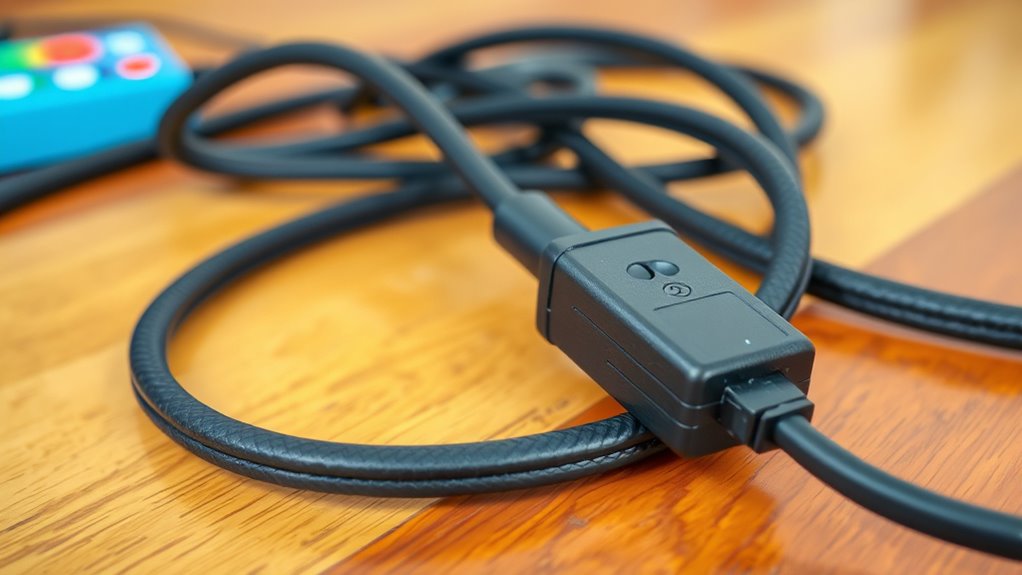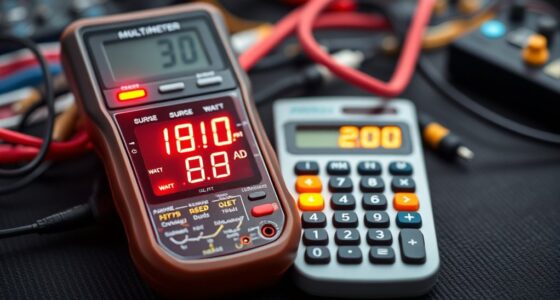To prevent voltage drop issues, match your extension cord’s gauge to your device’s power needs and keep the cord as short as possible. Thinner or longer cords increase resistance, reducing voltage and risking damage or performance issues. Regularly inspect cords for damage and avoid daisy-chaining. Properly selecting and maintaining cords guarantees safe, efficient operation. Keep these tips in mind — understanding the details helps you avoid guesswork and get the best performance from your extension cords.
Key Takeaways
- Calculate voltage drop using the formula: (2 x Length x Current x Resistance per unit length) / 1000 to ensure proper cable sizing.
- Choose extension cords with appropriate gauge ratings based on device wattage, current, and length to prevent voltage loss.
- Keep cords as short as possible and avoid daisy-chaining to minimize resistance and voltage drop.
- Regularly inspect cords for damage, ensure weatherproofing for outdoor use, and replace any worn or undersized cords.
- Position outlets closer to high-demand devices and avoid overloading circuits for safe, efficient power delivery.
Understanding Voltage Drop and Its Impact on Your Devices

Understanding voltage drop is essential because it directly affects how well your devices perform. When voltage drops along your extension cord, it can cause instability in voltage levels, reducing voltage stability. This fluctuation can lead to devices not functioning properly, as they rely on consistent power to operate efficiently. Reduced voltage stability may result in dimming lights, slower appliance operation, or unexpected shutdowns. The longer or thinner the extension cord, the more significant the voltage drop, which impacts device performance. Recognizing this connection helps you choose the right extension cord and ensure your devices receive a stable, adequate power supply. Proper cable sizing and maintenance are important to prevent excessive voltage drop. By maintaining voltage stability, you optimize device performance and prevent potential damage caused by inconsistent voltage levels.
Factors That Influence Voltage Drop in Extension Cords

Several factors can influence how much voltage drops along an extension cord, affecting your devices’ performance. The wire gauge plays a vital role; a thinner gauge (higher number) offers more resistance, increasing voltage drop. Conversely, a thicker wire (lower gauge) reduces resistance, maintaining better voltage levels. Cord length also matters: the longer the extension cord, the greater the voltage drop, because resistance accumulates over distance. If your cord is too long or has a thin wire gauge, your device might not receive enough voltage to operate correctly, leading to performance issues or damage. To minimize voltage drop, choose a cord with an appropriate wire gauge for your power needs and keep the cord length as short as practical. These factors directly impact the efficiency and safety of your setup. Additionally, understanding the eye patch benefits can help maintain the health of delicate skin around your eyes, ensuring your skincare routine supports overall eye comfort and appearance.
How to Calculate Voltage Drop for Your Setup

Calculating voltage drop in your setup helps guarantee your devices receive adequate power and operate safely. To do this, you need to take into account your wire gauge and length considerations. First, identify the current your devices draw, then measure the total length of the extension cord from the power source to the device and back. Use a voltage drop calculator or formula: Voltage Drop = (2 x Length x Current x Resistance per unit length) / 1000. Resistance depends on the wire gauge; thinner wires have higher resistance. For longer lengths, voltage drop increases, especially with smaller gauge wires. Additionally, understanding the contrast ratio of your setup can help ensure your image quality remains high despite voltage fluctuations. By performing this calculation, you ensure your extension cord can safely power your devices without excessive voltage loss, preventing potential damage or unsafe operation.
Selecting the Right Extension Cord for Your Needs
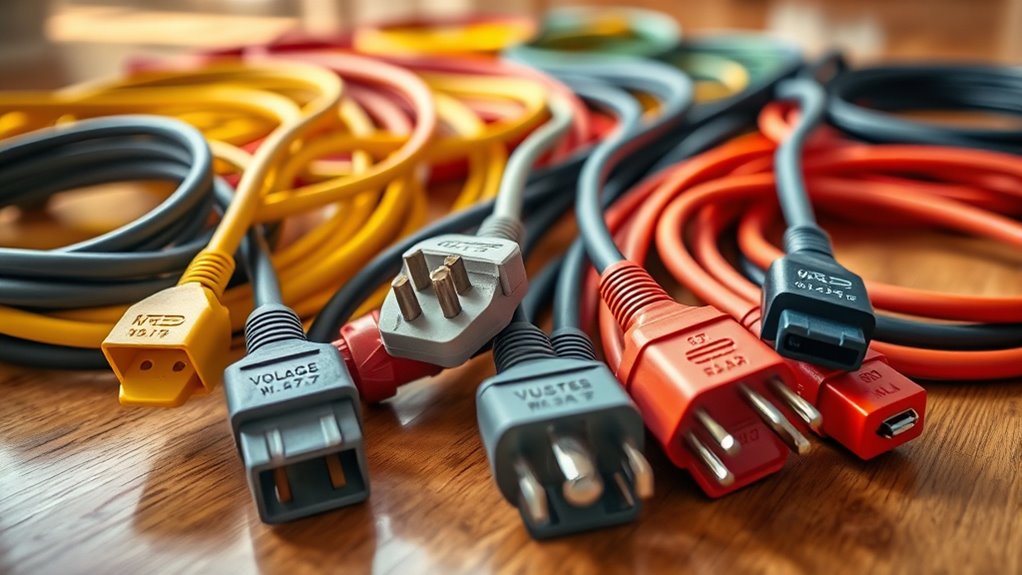
To select the right extension cord, you need to evaluate your power requirements first. Then, consider the cord’s gauge and length to guarantee it can handle the load without excessive voltage drop. Picking the correct combination helps keep your devices safe and functioning properly.
Power Requirements Analysis
Choosing the right extension cord starts with understanding your power requirements. You need to assess your power load—how much current your devices draw—and compare it to your circuit capacity to prevent overloads. This guarantees safety and ideal performance. To do this effectively, consider:
- The total wattage of all connected devices
- The amperage rating of your circuit
- The maximum current the extension cord can handle
- The length needed to reach your power source
Matching your power load with the circuit capacity helps avoid voltage drops and potential hazards. Always select a cord that exceeds your maximum power load slightly for added safety. Proper analysis ensures you choose an extension cord that’s safe, reliable, and suited for your specific needs. For a comprehensive approach, understanding personality traits can help you better evaluate your own needs and preferences when selecting tools or equipment.
Cord Gauge and Length
Selecting the right extension cord involves considering both its gauge and length to guarantee safe and efficient operation. The cord gauge determines how much current it can safely carry; lower gauge numbers mean thicker cords that handle more power, reducing voltage drop. Longer cords increase the risk of voltage drop, so choosing a shorter cord when possible helps maintain proper voltage. If you need a longer extension cord, opt for one with a thicker gauge to compensate for the increased length. Always match your cord gauge to your power needs and the length of the cord to prevent overheating and voltage issues. Properly selecting the right combination ensures your tools or appliances perform safely and efficiently without risking damage or hazards. Understanding wire gauge is essential for making the best choice in extension cords.
Best Practices for Safe and Efficient Extension Cord Use
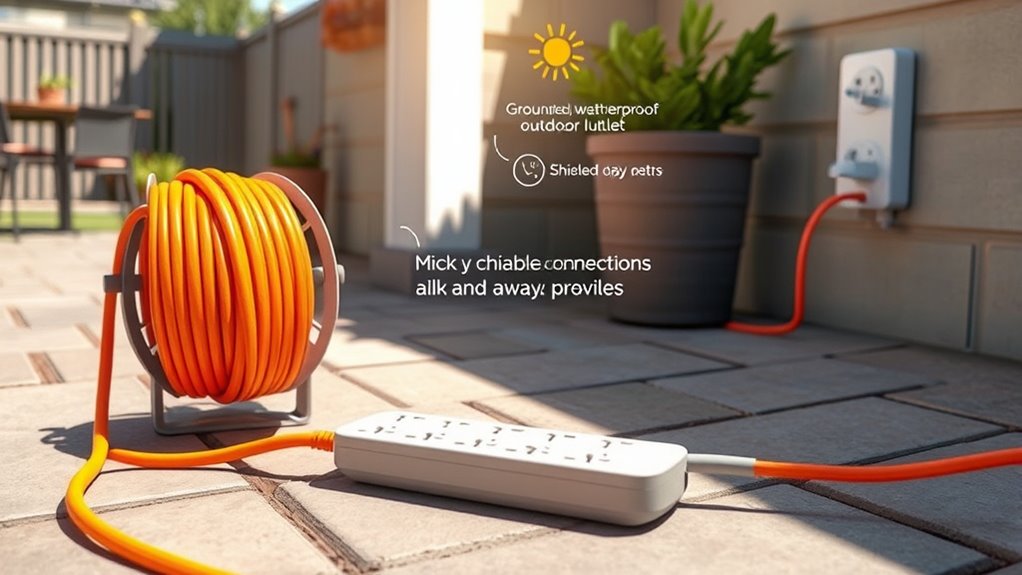
To guarantee safe and efficient use of extension cords, you need to choose the right cord for your task and environment. Always follow safety tips, like avoiding overloading and inspecting cords regularly. This way, you protect yourself and keep your equipment running smoothly. Using cords that are appropriate for your room size ensures optimal performance and safety.
Proper Cord Selection
Ensuring you pick the right extension cord is essential for safety and efficiency. Start by considering the cord material, which affects durability and flexibility. Choose cords with high-quality insulation to prevent electrical hazards and damage from environmental factors. Check the gauge of the cord—thicker gauges handle more current and reduce voltage drop. Always select a cord rated for the power load you need, and avoid daisy-chaining multiple cords. Being aware of city dynamics can help you better understand your environment and select cords suitable for outdoor or indoor use. Here are key points to keep in mind:
- Use cords with durable, weather-resistant insulation quality
- Select the appropriate cord material for your environment
- Match cord gauge with your power requirements
- Avoid overloading or using damaged cords
Proper selection ensures safe, reliable performance and minimizes risks.
Safe Usage Tips
Using extension cords safely involves following best practices to prevent accidents and maintain performance. First, choose a cord with the appropriate wire gauge for your load—thicker gauges handle higher currents better. Avoid using excessively long cords, as longer cord lengths increase voltage drop and reduce efficiency. Always inspect cords for damage before use, and never connect multiple extension cords together, which can cause overheating. Keep cords out of high-traffic areas to prevent tripping hazards, and avoid pinching or crushing them under furniture or doors. When in use, unplug cords when not needed to prevent overheating. Properly rated cords ensure safe operation and reliable performance. By selecting the right wire gauge, managing cord length, and follow these safety tips, you guarantee safe, effective extension cord use while minimizing risks.
Common Mistakes That Increase Voltage Drop and How to Avoid Them
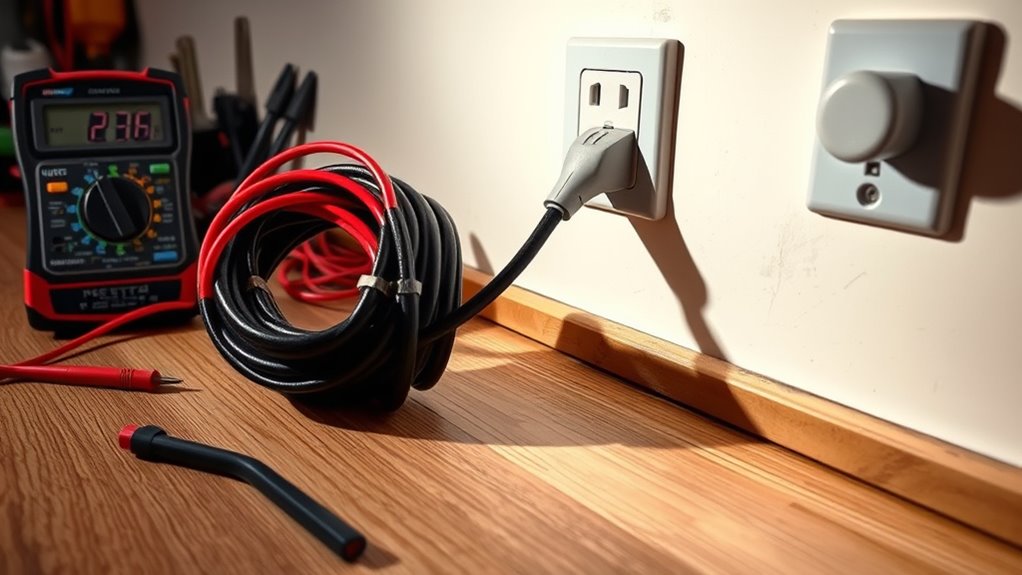
One common mistake that increases voltage drop is using extension cords that are too thin for the intended load. Poor wire gauge selection causes resistance to rise, reducing voltage at your device. Additionally, improper outlet placement can force longer cords, increasing voltage loss. To avoid these issues:
Using thin extension cords and poor outlet placement increases voltage drop and reduces device performance.
- Choose the right wire gauge based on your load requirements
- Keep extension cords as short as possible to minimize resistance
- Avoid daisy-chaining multiple cords, which adds resistance
- Position outlets closer to high-demand devices to reduce cord length and voltage drop
- Remember that remote work setups often require reliable power sources to maintain productivity and safety.
Tips for Maintaining Optimal Electrical Performance Outdoors
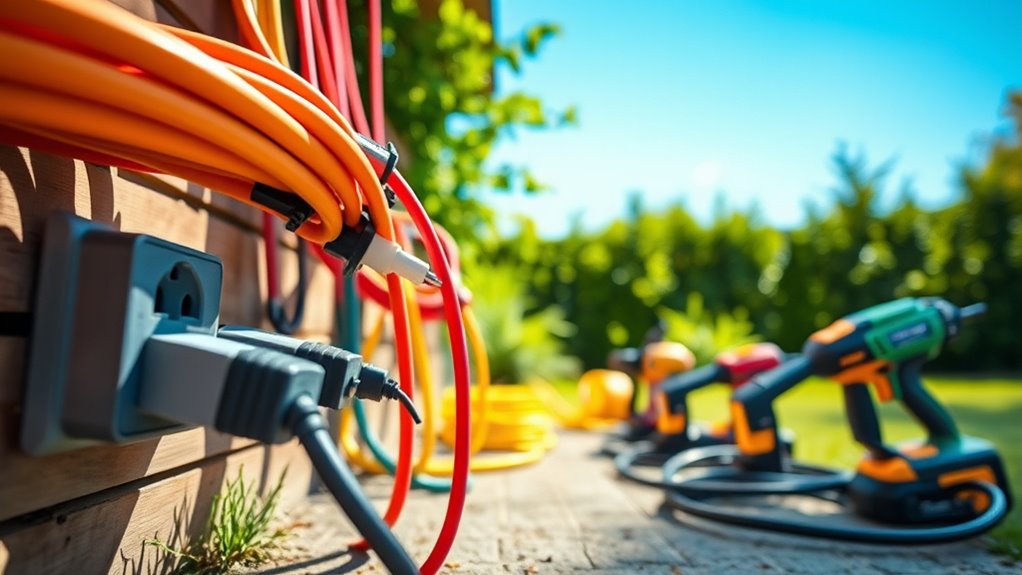
Outdoor electrical setups face unique challenges, so it’s vital to maintain your equipment properly to guarantee safety and performance. Regularly inspect outdoor outlets, extension cords, and wiring for damage or corrosion. Use weatherproof covers and protect indoor wiring from exposure to moisture. Make sure circuit breakers are functioning correctly and reset them if they trip unexpectedly. Proper grounding and surge protection are essential to prevent damage. Avoid overloading circuits and always use cords rated for outdoor use. Here’s a quick comparison:
| Indoor Wiring | Outdoor Maintenance |
|---|---|
| Less exposed | Needs weatherproofing |
| Less corrosion | Check regularly |
| Use in dry areas | Use outdoor-rated cords |
Maintaining proper electrical safety is crucial to prevent accidents and ensure reliable operation outdoors. Keeping these tips in mind helps maintain excellent electrical performance and safety outdoors.
Frequently Asked Questions
How Does Temperature Affect Voltage Drop in Extension Cords?
Temperature affects voltage drop because heat impact increases resistance in extension cords, leading to more voltage loss. When temperatures rise, poor insulation quality can worsen this effect, as heat accelerates deterioration. You’ll notice that in hot conditions, your cord’s efficiency drops, and voltage drops become more significant. To minimize this, choose cords with good insulation quality and avoid exposing them to high temperatures, ensuring safe and reliable power delivery.
Can Using Multiple Extension Cords Increase Voltage Drop?
Using multiple extension cords can definitely increase voltage drop because longer extension cord length adds resistance, causing more voltage loss. When you connect cords, you’re effectively increasing the total length, which reduces power capacity and can lead to insufficient voltage for your devices. To avoid this, use the shortest extension cord possible and make sure it’s rated for your equipment’s power capacity, keeping voltage drop within safe limits.
What Are the Signs of Excessive Voltage Drop in Devices?
You’ll notice excessive voltage drop if your devices lose power, flicker, or operate sluggishly. Power loss caused by high wire gauge or long extension cords can reduce voltage reaching your equipment. If your devices aren’t functioning properly or seem weaker, it’s a sign of voltage drop. To prevent this, use appropriately gauged wires and limit cord length, ensuring your devices get sufficient voltage and avoid unnecessary power loss.
How Often Should I Inspect My Extension Cords for Safety?
You should inspect your extension cords regularly, ideally every few months, to guarantee safety. Follow safety guidelines by checking for frayed wires, damaged insulation, or loose connections during each cord inspection. If you notice any issues, replace the cord immediately to prevent hazards. Regular inspections help you spot potential problems early, reducing the risk of electrical shocks or fire, and keep your workspace safe and secure.
Are There Specific Extension Cord Types Recommended for High-Power Tools?
Think of high-power tools as a roaring river—they need a strong, steady path. For these, you should choose extension cords with thicker wire gauge selection, like 10 or 12 gauge, to handle the current reliably. Opt for cords with heavy-duty cord insulation, designed to withstand heat and wear. This ensures minimal voltage drop, keeps your tools running smoothly, and prevents overheating or damage during tough jobs.
Conclusion
Now that you know how voltage drop affects your devices, are you ready to choose and use extension cords smarter? By understanding the factors involved and following best practices, you can keep your equipment running safely and efficiently. Don’t let poor connections or wrong choices drain power and damage your gear. Isn’t it worth taking a few extra steps to ensure reliable performance and safety? Start applying these tips today and enjoy peace of mind with every extension cord you use.
